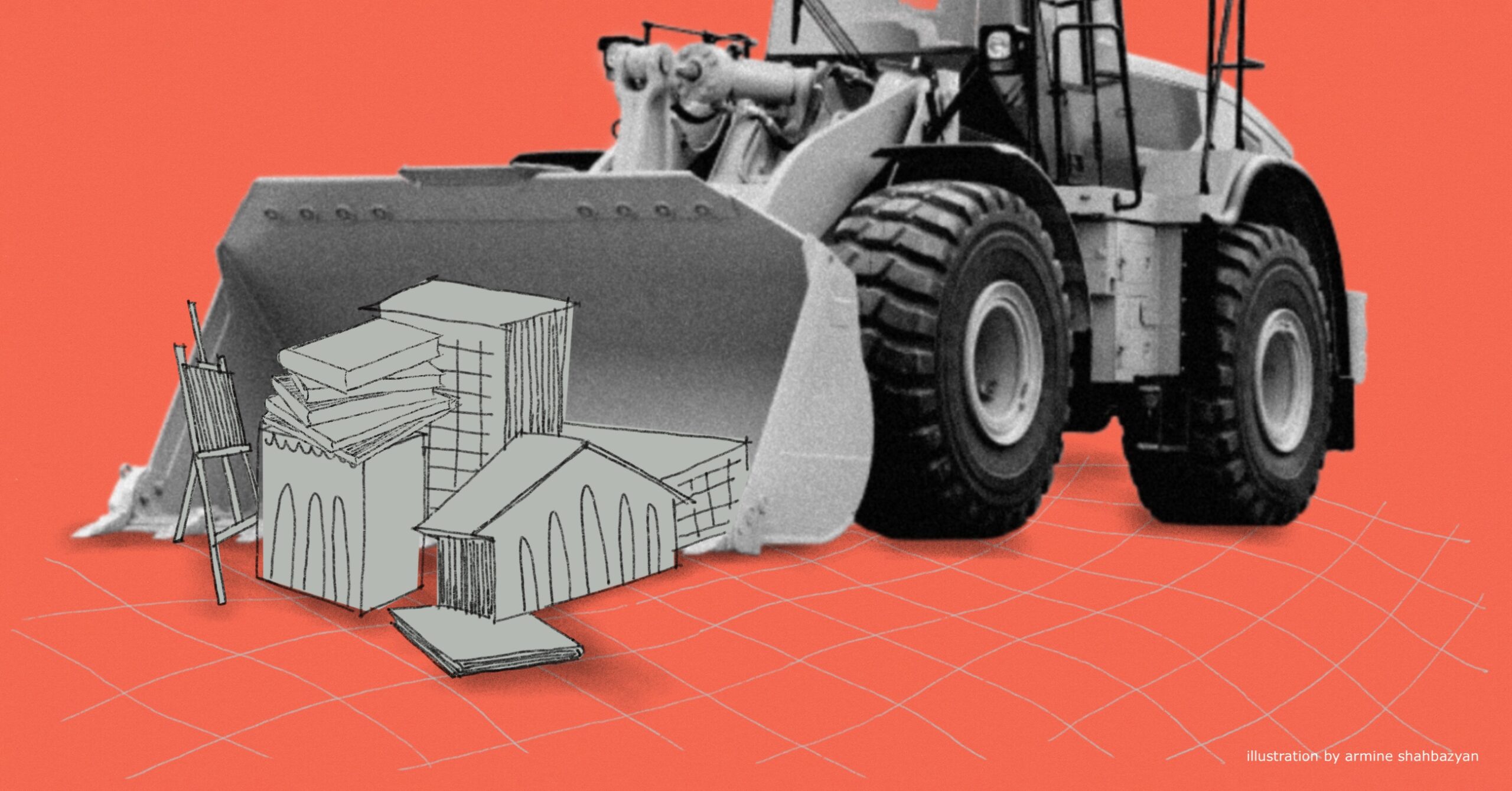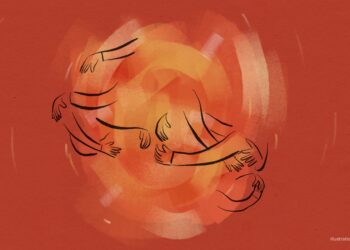
Listen to the article
The Armenian government’s proposed Academic City project aspires to establish Armenia as a major player in the global scientific, educational, and innovation sectors. Though still in the design phase, this large-scale initiative has already generated both skepticism and controversy.
The concept was first introduced by Prime Minister Nikol Pashinyan in March 2021. According to Pashinyan, the Academic City would be a place “where the scientific and academic potential [of the country] would be centralized,” and its construction would be funded by the sale of state-owned university buildings, most of which are in central Yerevan and since most of them no longer meet 21st-century standards.
The announcement about the construction of the “New City,” and the potential sale of existing university buildings, provoked a significant response. The then Minister of Education, Science, Culture and Sports Vahram Dumanyan clarified, “If that city becomes a reality, many universities will naturally want to relocate to that beautiful location… However, even if all those buildings are sold, that money will not be enough. Serious investments will be required.”
The government program, adopted in August of 2021, cited the establishment of the Academic City as a project of “strategic importance,” despite the project not being mentioned in the ruling party’s pre-election program during the snap election that took place two months prior.
Further clarification on what the Academic City would entail, other than buildings and infrastructure, came a year later. The “State Program for the Development of Education of the Republic of Armenia until 2030” describes the Academic City as a set of campus clusters that provide a modern educational environment for quality higher education and research. “The Academic City will ensure expanded networking and synergistic cooperation among educational institutions, scientific institutions and manufacturing, incorporating modern virtual, social, as well as physical infrastructures.”
Consequently, Pashinyan emphasized the government’s obligation to lift the higher educational system out of a deep crisis. He stressed the government’s commitment to establishing universities that meet international standards, with the state taking full responsibility for their funding. “After 2027, we will not allow universities that do not meet certification licensing conditions to exist in the Republic of Armenia,” Pashinyan stated. “In Armenia, universities will operate solely in the Academic City. We will provide a space for everyone, and everyone must accept this choice.”
The Academic City project took shape, at least on paper, with the state’s adoption of its implementation timetable in October of last year. The document outlines the goals of the project, which include having at least four universities in the top 500 international rankings and doubling the number of foreign students. It also plans to expand state universities by merging them with research institutes. This aims to enhance the quality and competitiveness of research and facilitate effective generational change.
According to the plan, the City will be able to physically accommodate up to 16 universities: up to eight state expanded universities and up to eight private or international universities.
A crucial part of this plan is the creation of four academic clusters:
- A technological cluster: This will accommodate approximately 14,500 university students, 500 high school students, and about 3,000 faculty members. It will bring together various research and technological centers. The Technological High School will also be situated on campus, offering science, technology, engineering, and mathematics-oriented educational programs for senior classes.
- Arts cluster: This is planned for approximately 2000 students and 200 apprentices. It will include around 900 academic staff members and will unite the culture, heritage, and arts center, the high school of arts, and have a modern theater-cinema-concert hall, as well as spaces for seminars and workshops. The inclusion of secondary professional education programs is also planned, and a film city could potentially be added to the same area.
- Educational Cluster: Designed for roughly 15,000 students, and 1,400 academic staff, this cluster will also incorporate an educational research center.
- Officer Cluster: The structure and capacity of the officer cluster will be determined through professional consultations. The officer university will have two national security departments, external security and internal security. An Officers’ High School and College will also be part of this cluster.
Related state and private entities will relocate to the Academic City including the higher education and science committee of the Ministry of Education, Science, Culture and Sports.
The documents mention two sites under consideration for the Academic City: one near the 17th district of Yerevan, adjacent to the interstate M1 road leading to Ashtarak, which is mainly state or community owned property, and the other is the Hamo Beknazaryan Hayfilm Studio. Collectively, these sites span approximately 700 hectares.
The academic City will be connected to the capital by railway. Within the City, mobility will be regulated with special provisions, including for cycling and electric transportation.
The concept outlines that the academic city and its surrounding areas will be home and workplace to approximately 44,000 people. Some of these will require living accommodations, dormitories (students, junior researchers, and professors) or serviced apartments (senior professors and researchers).
In addition to educational facilities, the academic city will be home to several other ambitious projects like a national stadium designed to accommodate up to 35,000 spectators.
Funding for this project is expected to come primarily from the state budget, along with investments or loans from international financial partners. According to the most preliminary calculation, 1.2 trillion drams would be required for the construction of the City. Private sector investors may also contribute funds for the construction or management of housing, sports facilities, and other domestic purposes. However, this will be under specific conditions to ensure adherence to the master plan and maintain the city’s harmony in the future.
The Academic City’s construction schedule comprises three main phases:
- The design phase, which began in October 2023, and is slated for completion in September 2025.
- The construction phase which is anticipated to commence in October 2025 and, according to initial estimates, conclude in December 2029.
- The service phase, which is scheduled to begin in January 2030.
The Problem
This attempt to radically transform higher education in the next six years has drawn significant criticism. Nearly all large universities have expressed their opposition to the proposed expansions and relocations. Furthermore, the future of historic university buildings that give the city its character remains uncertain.
As of 2023, there are 67 higher education institutions in Armenia, with 31 being non-state. The student population totals 71,732, with 59,169 enrolled in state universities. The number of employees in state universities is 15,252, whereas non-state universities employ 1,883).
Many experts agree that the number of universities in Armenia is quite high considering the country’s size and number of students. They agree, the number should be reduced to increase efficiency. However, they foresee problems implementing this through the Academic City.
“Although I agree that the number of universities in Armenia is large and some mergers are possible, the extensive program currently being proposed threatens both university education and science,” says Serob Khachatryan, an education expert and lecturer at Yerevan State University. He points out the lack of research underpinning this initiative, which could shed light the problems that universities currently face.
Samvel Karabekyan, another higher education expert, believes that the expansion of universities is not only urgent, but perhaps even overdue.
“This process is accompanied by measures aimed to integrate science and higher education, with the goal of creating a model in which both are concentrated within universities,” says Karabekyan. He notes that this model raises many questions. One of them involves the nature of the newly formed, expanded universities.
Karabekyan suggests it would be appropriate to establish two or three multidisciplinary universities, which might have their educational institutions in different cities.
“Each will organize their specific educational programs on different campuses, ensuring they contribute to the development of their local communities,” says Karabekyan. He says, “Universities have a civilization-creating, environment-creating function, especially in small towns.”
Most of Yerevan’s universities are currently located in the city’s central, busiest parts, forming a university district in itself. According to Alexander Tamanyan’s master plan for the capital, the northern part of the city was allocated to be a student zone, where a number of state universities were subsequently built. The area also houses the largest repository of Armenian literature, the National Library of Armenia, and other cultural and scientific institutions. Both students and professors frequently use their services.
“Next to the conservatory is the Opera Theater and music schools that are in direct contact with one another. Additionally, the medical university has university hospitals where students do internships, all conveniently located near the medical university,” says Khachatryan. He notes that this ecosystem will be disrupted with the proposed changes.
Regarding the idea that relocating will decongest Yerevan, especially the center, Khachatryan views this as a highly relative solution, He points out that the proposed location, the 17th district, is also in Yerevan and consequently, parts of the city, the Ajapnyak and Arabkir districts will be overloaded.
However, besides technical issues, experts also warn about serious substantive problems. Tigran Shahverdyan, a member of the Gituzh Initiative which aims to empower Armenia through science and technology and co-founder of Robomart, believes that many components of the program are not justified. Although regular meetings take place, there are no substantive discussions. According to Shahverdyan, they have confirmed many times the need to merge scientific institutions. However, there is no discussion about the goals, targets and criteria based on which the scientific research organizations and their subunits should be united or not.
“Meanwhile, they are already discussing plans, allocating space, and so on. If we want to be a competitive country, we need to put in place a system of scientific research and experimental development that serves to solve the problems of our country, instead of conducting experiments without setting clear goals,” says Shahverdyan. He adds that they share the concern about the risks associated with concentrating all intellectual potential in one place. An additional concern is that the scale, budget and implementation phases of the program are also not clear.
One of the key goals of the program is to eliminate the divide between higher education and science. However, Shahverdyan believes that this does not justify merging all the scientific institutions funded by the Ministry of Education, Science, Culture and Sports with universities. As international experience shows, it is possible to ensure this integration within the existing system.
“There are two ways to ensure this integration; one, when the research component is developed within the universities, two, when the researchers are lecturers at universities and at the same time work at research institutes. This practice is used globally, but they do not talk about the second option.”
Zhanna Andreasyan, Minister of Education, Science, Culture and Sports, admitted that there are numerous concerns and lingering uncertainties regarding the large-scale project. She presented the concept of the master plan for the Academic City at the Matenadaran this April.
“We are dealing with a very large project, and at this moment, we do not have answers to all the questions. This is a process where we also learn as we go. Nevertheless, the trust we have in the end goal and targets is very important. If we have bigger ambitions to compete internationally, these changes have no alternative,” the minister said.
However, education expert Serob Khachatryan says the underlying issue for Armenian universities is that the two main actors in the education sphere are not motivated to challenge the status quo.
“Our problem is that the majority of students do not want to learn; they do not have the motivation. We have thousands of students that graduate without learning anything, without acquiring substantive knowledge, and we have a significant number of lecturers that are not particularly interested in teaching,” says Khachatryan. He adds that the issue will not be solved by moving them to the 17th district, risking large investments without any guarantees.
Samvel Karabekyan is sure that just in terms of urban planning, the academic city still has a long way to go, “This project will not be realized within the next decade. We haven’t assessed our abilities properly. It is extremely important to develop a realistic plan and calculate all the resources needed for its implementation.”
Raw & Unfiltered
Armenia’s Commitment to Remembering the Yezidi Genocide
A crucial step in helping to prevent future genocides includes commemorating genocides and remembering their victims. The Armenian government recently designated August 3 as Yezidi Genocide Commemoration Day, becoming one of the first countries in the world to do so.
Read moreFrom Riches to Racism: The Enduring Legacy of Armenian Merchants
European stereotypes of the mercantile Armenians over the last 500 years persist in contemporary discourse among Armenia’s neighbors. Understanding the proliferation of these stereotypes and their origin is imperative for lasting peace in the South Caucasus.
Read moreA New Approach to Aging: Redefining the Journey
Amidst a lively gathering, seniors engage in therapeutic activities and form connections at the Memory Café, an initiative by Alzheimer’s Care Armenia promoting healthy aging and social interaction. What is the state doing about the country’s aging population? Gohar Abrahamyan explains.
Read moreEmbracing a Culture of Kindness
While Armenians pride themselves for their hospitality towards foreigners, sometimes the same gesture isn’t extended to their fellow Armenians, particularly to those in need. If we could learn to embrace kindness and share this generosity, we could greatly enhance the well-being of all Armenians, writes Ella Kanegarian-Berberian.
Read moreBorn Too Soon: Challenges of Premature Births in Armenia
When she unexpectedly had to deliver her first baby at 29 weeks, Hranoush Dermoyan had no idea what the journey ahead entailed. Weighing only 700 grams, her daughter spent the first 75 days of her life in NICU. The experience revealed emotional and medical challenges, and healthcare disparities in Armenia.
Read moreThe Family Puzzle: Which Is Traditional?
A number of factors have continuously impacted the family structure in Armenia. Despite concerns that the influence of Western culture is causing the traditional multigenerational family to break down, nuclear and alternative family structures have been around in Armenia much longer than many believe.
Read moreTransgression Object: How A Nice Mormon Boy Made a Lot of Azerbaijani Enemies
A personal account by Alexander Thatcher of what it means to be targeted and attacked by Azerbaijani trolls, a kind of harassment made possible because of the ambiguity afforded by anonymity.
Read moreDeciding to Untie the Knot: Divorce Rates on the Rise
Over the past decade, the number of marriages in Armenia has been decreasing, while divorces are on the rise. Gohar Abrahamyan looks at the psychological, social and financial implications of deciding to untie the knot.
Read more









Pashinyan’s “Academic City” will drive the nail in Armenia’s coffin.